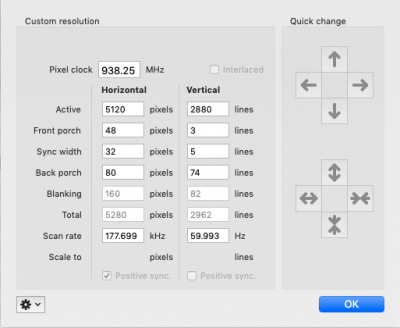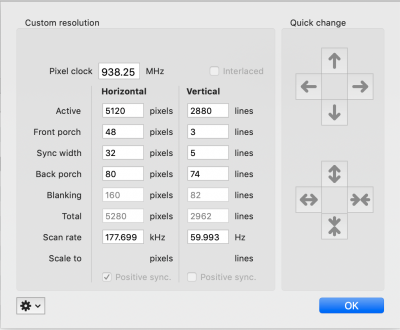This suggests that even a real Mac connected via TB3 to an LG 5K is sending a 4K signal from the video card to the monitor, and that signal is being scaled up to 5K by the monitor.
Only when it's not working properly. Wrong cable or bad connection or something.
Do you think there would be a noticeable difference in image quality if the video card sent a 5K signal, thereby omitting two of the three scaling operations? Namely: MacOS would scale 2560x1440 into a 5K framebuffer that would be sent as-is to the monitor. What’s happening now is the scaling-down of this framebuffer to 4K and a subsequent scaling-up to 5K.
macOS doesn't scale 2560x1440 up to 5K. In HiDPI mode, it draws things 4 times larger. Heights and Widths are doubled. font size is doubled. Take a look at the differences between these two screen shots.


In effect, we are trying to determine whether this Hackintosh interfaces the same way as a real Mac to the LG 5K. If it does, then we have nothing to complain about!
If it's not outputting 5K, then you have something to complain about. It should work properly if two DisplayPort 1.2 signals are being sent over the 40 Gbps Thunderbolt cable.
Edit: Homework assignment for LG 5K owners: It would be interesting to see what happens when scaling is turned off and we set the resolution to 5K. Hence, "UI Looks Like" will also be 5K for very tiny text.
Unnecessary. It will be like the "Looks Like 2560x1440" except everything will be drawn at normal size.
That explains it. Need 40 Gbps for 5K.
In the AGCDDiagnose output, I see the following:
Connected to the Intel iGPU is one four lane DisplatPort 1.2 connection to a device from 204-45-140 = "LG ELECTRONICS INC" with name "22MD4K"
Connected to the AMD dGPU is two four lane DisplayPort 1.2 connections to a device from the same LG with names "22MD4K" and "27MD5K"
For some reason there are three different EDIDs. The EDIDs for 22MD4K are similar but the one connected to the iGPU has a date from 2016 and the one connected to the dGPU has a date from 2017. The serial numbers are also different (the one in the dGPU is higher). The 27MD5K has an even higher serial number. It has info about the tiling of the display (the display is two tiles, the 27MD5K lists the tile for the left side). I used edid-decode. I don't think it's able to parse everything though. I should make my own parser one day...
Yup, your screenshot shows it's not working at 5K.
I think being TB3 cable implies it's 40gbps. TB2 would be 20gbps
This is probably because you don't have enough bandwidth to drive the 5K using a 20gbps cable (TB2 cable I guess?)
Some passive cables are too long to run at 40 Gbps. They will run an 20 Gbps. For long Thunderbolt 3 cables, you need an active cable. Yes, 20 Gbps is not enough for 5K, and yes, TB2 cables are also 20 Gbps but that doesn't matter, because to use a TB2 cable with a TB3 device, you would need one or two Apple Thunderbolt 3 to Thunderbolt 2 adapters which reduce the bandwidth to 20 Gbps. It might be interesting to see if the really long TB2 optical cables can work with Thunderbolt 3 devices using a couple Apple Thunderbolt 3 to Thunderbolt 2 adapters (but they will be limited to 20 Gbps).
However, have a look at these photos I took this past January of the 2018 Mac Mini connected to previous gen LG 5K.
It shows link speed of 20 Gbps and width of x2. Default scaled resolution for this monitor is the same as JayShay reported.
Because these photos were taken at an Apple Store, I believe they used the cable that comes in the LG box.
They used the wrong cable or a bad cable. Note that Thunderbolt can be one or two lanes that can transmit at 10 or 20 Gbps. Thunderbolt 2 added the ability to join both lanes together for a single link.
These are some of the possibilities:
1) "Speed: Up to 40 Gb/s x1. Current Link Width: 0x2". Two lanes of 20 Gb/s acting as 40 Gb/s x1.
2) "Speed: Up to 40 Gb/s x1. Current Link Width: 0x1". Not valid. No device connected.
3) "Speed: Up to 20 Gb/s x1. Current Link Width: 0x2". Two lanes of 10 Gb/s acting as 20 Gb/s x1. This could be a long passive Thunderbolt 3 cable, or USB-C cable used for Thunderbolt 3, or a Thunderbolt 2 cable or device.
4) "Speed: Up to 20 Gb/s x1. Current Link Width: 0x1". One lane of 20 Gb/s. The other lane is not connected because it's bad?
5) "Speed: Up to 10 Gb/s x1. Current Link Width: 0x1". One lane of 10 Gb/s. This is a Thunderbolt 1 device.
yeah, I have old model. Was this 40Gbps test based on having the new one? This monitor works at 5K with my 2018 iPad Air with the 20 Gbps cable.
It probably doesn't work at 5K with a 20 Gb/s cable. Check the SwitchResX timing. Check the Thunderbolt link speed and width.
I just realize that unless the real Mac we use for testing got inside the Titan Ridge and we connect it to the 2019 lg 5K it will default to DP1.2 because the Mac will have the Alpine ridge instead
Yup. The entire path from GPU to LG display needs to support DisplayPort 1.4 if you want to test DisplayPort 1.4. This means AMD or Nvidia graphics as the source and any Thunderbolt devices in the chain need to be 40 Gb/s (Alpine Ridge or Titan Ridge) and the first and last Thunderbolt devices in the chain need to be Titan Ridge (the first converts DisplayPort 1.4 to Thunderbolt 3, which can be carried by Alpine Ridge; the last must be Titan Ridge to convert Thunderbolt to DisplayPort 1.4).


